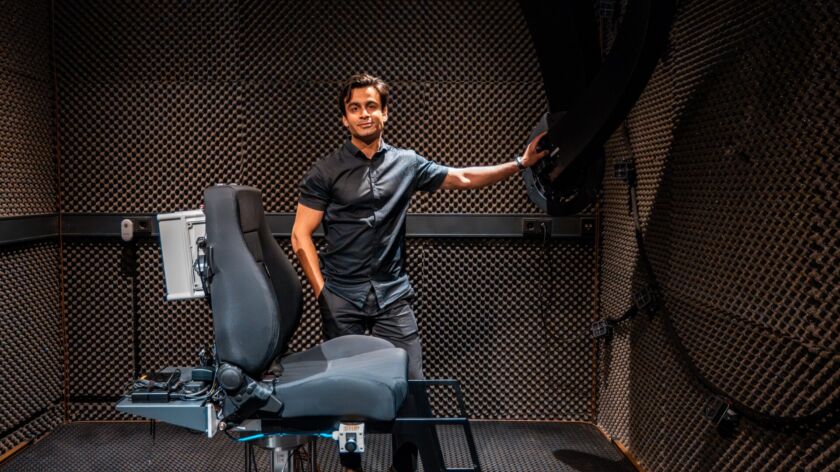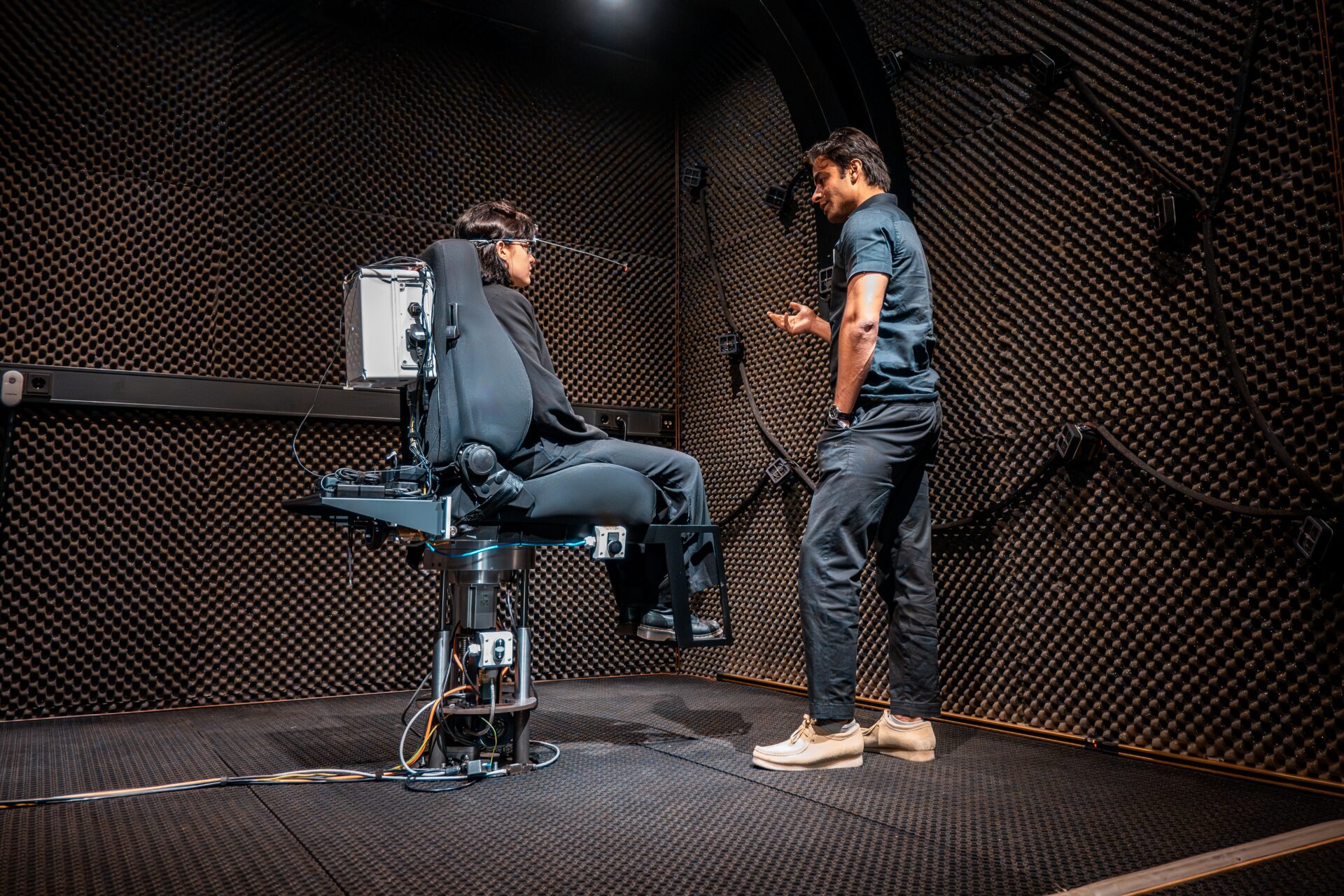How does your brain track moving sounds? Donders research contradicts long-held belief
-
 Photo by Diede van der Vleuten
Photo by Diede van der Vleuten
When a car passes by, even without seeing it, we can accurately follow it based on its sound – however, it’s not known how the brain processes this auditory information. Researchers at the Donders Institute study this using a unique lab, the only one of its kind in the world. ‘Proving the existence of auditory pursuit is merely the tip of the iceberg.’
The door clicks shut. Complete darkness. I’m standing in the magnetic field of a soundproof room, wearing a weird-looking glasses frame with a coil, designed to record head movements. ‘Your task is to follow the sound with your head as accurately as possible,’ Snandan Sharma instructs while adjusting the glasses on my face. ‘Try not to think about it, this should be as quick as a reflex.’
The Pursuit Lab is set up in the basement of the Huygens building and took almost two years to build. Sharma and his research group at the Donders conduct experiments in this innovative space to investigate how we perceive moving sounds. ‘If an ambulance is passing by and you close your eyes, you can follow the sound precisely. But no one really knows what mechanisms in the brain are helping us to do that because this was never really studied.’ Until now.
Auditory Pursuit
When a sound arrives to your ear, the only information available to you is sound frequency, not sound position – still, humans are some of the best sound localizers on the planet. And, according to Sharma and his team, previous scientific literature had it all wrong when it came to the brain’s ability to perceive moving sounds.
‘So far, we believed that auditory pursuit does not exist,’ Sharma explains. ‘When I say pursuit, it means that our brain is sensitive to sound motion position – where a moving sound is positioned in space – but more importantly, it’s also sensitive to the velocity of the sound. The current narrative in the scientific literature suggests that we only take ‘snapshots’ of sound position, meaning that we cannot smoothly follow sounds. But that would lead to huge errors in daily life. And we just proved that it’s not the case.’
‘Our work has important implications for people with hearing impairments’
For cochlear implant users (users of a small electronic device with a mic for picking up sounds that bypasses the damaged parts of the ear directly stimulating the auditory nerve, ed.), however, localizing sounds remains a challenge. ‘These people face a lot of difficulty in localizing stationary sounds, so we can imagine that localizing moving sounds in a realistic environment would be even more challenging for them,’ according to Sharma. ‘We are addressing a significant gap in our understanding of the auditory system, which has important implications for people with hearing impairments.’
‘Cochlear implant users can’t process binaural cues (see box, ed.) and often lack spatial awareness regarding sound localization,’ Sharma explains. ‘This can be unsafe as they might confuse the direction from which a car is coming, for instance.’
What are binaural cues?
Sounds reach your ear without any coordinates, but at a perceptual level, people know clearly where the sounds are coming from. When somebody unexpectedly drops an object nearby, they immediately turn their head towards the clumsy person. That is because, for localization in the horizontal plane (front-back, left-right), the brain uses the difference in how loud the sound is in one ear compared to the other and how quickly the sound reaches each ear.
If a sound is, for instance, coming from the right, it will be louder in your right ear and arrive there faster. This is because of the size of the head, which acts as a barrier. These differences are called binaural cues, meaning they involve both ears. Those binaural cues are extremely small as sound travels very fast and the distance between your ears is quite short. The brain can perceive even a difference of 10 microseconds between the ears. That is one 100,000th of a second.
Previous research approaches to sound motion tracking, like testing sound perception by monitoring eye movements, had a notable drawback. And, as Sharma explains, it turned out that asking participants to follow moving sounds with their heads in a completely dark room was the key.
According to the researcher: ‘Previous studies asked participants to follow a moving sound with their eyes while keeping their heads fixed. However, when you move your eyes, you do not receive feedback from the moving sound. Results from these experiments led to the popular belief of the absence of auditory pursuit in humans. Moving your head is what changes the binaural cues for sound localization. This was the missing link. In our lab, we study auditory pursuit by measuring both the head and eye movement responses.’
Vertical
Proving the existence of auditory pursuit is merely ‘the tip of the iceberg,’ as Sharma describes it. ‘So far, we have only demonstrated this in the horizontal plane, and we are very curious to see the responses to sounds moving in elevation because no one has ever studied this before,’ he says excitedly. ‘The Pursuit Lab can generate horizontal and vertical sound motion, and the chair can also rotate the participant.’
On the more clinical side, the team has previously conducted extensive studies with cochlear implant users focusing on stationary sounds in close collaboration with Radboudumc and cochlear implant manufacturers. Now, taking a step further and building on their discovery, the plan is to investigate moving-sound-tracking in cochlear implant users either this year or next year.





Joanne Verhulst schreef op 10 november 2024 om 12:23
Very interesting to me, especially because I have severe tinnitus and hyperacusis. So if you would use me as a test person your results compared to normal hearing could give you clues too. Yesterday e.g. I crossed the street without looking, although I could hear a car coming from the left. I guess I am still able to detect speed by sound…